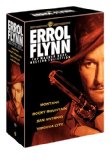| Reviews & Columns |
|
Reviews DVD TV on DVD Blu-ray 4K UHD International DVDs In Theaters Reviews by Studio Video Games Features Collector Series DVDs Easter Egg Database Interviews DVD Talk Radio Feature Articles Columns Anime Talk DVD Savant Horror DVDs The M.O.D. Squad Art House HD Talk Silent DVD
|
DVD Talk Forum |
|
|
| Resources |
|
DVD Price Search Customer Service #'s RCE Info Links |
|
Columns
|
|
|
Errol Flynn - The Warner Bros. Western Collection (Virginia City, San Antonio, Montana, Rocky Mountain)
Collecting together four rip-snortin', pistol-packin' oaters starring Hollywood's premiere action star of the 1930s and 1940s, Errol Flynn - The Warner Bros. Western Collection should please fans of the genre and star with its clean transfers and copious bonus features. Titles here include 1940's Virginia City, 1945's San Antonio, and 1950's Montana, and Rocky Mountain, all of which (with the exception of the rather remarkable, underappreciated Rocky Mountain) fall into that now neglected category of the Hollywood Western - the big studio, non-psychological Western - that fitted comfortably in-between the myriad smaller-budget "B" oaters from the silent era to the '30s and '40s that have so many fans to this day, and the coming "psychological" Westerns of the early '50s and beyond, when the genre "grew up," according to some, and incorporated modern dramatic themes found in other post-WWII film genres. All of these titles, so far, aren't available separately, so this set is a good opportunity to fill out your sagebrush and Flynn collections. Let's look at the individual films, where I'll discuss Flynn's appeal in more detail as we chronicle this period of his career.
VIRGINIA CITY
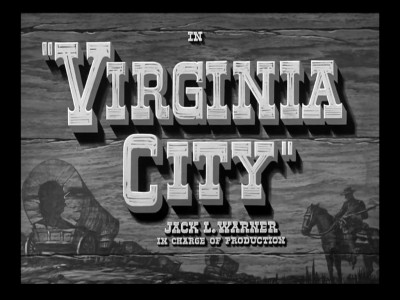
Flynn plays Union Captain Kerry Bradford, who along with his sidekicks "Marblehead" (Guinn "Big Boy" Williams) and "Moosehead" (Alan Hale), are trying to tunnel their way out of the notorious Libby Prison in Richmond, Virginia. Their plan is seemingly foiled, though, by the prison's commander, Confederate Captain Vance Irby (Randolph Scott), who has known about the tunneling for months, and has allowed the prisoners to unwittingly proceed at the grueling physical punishment. Bradford swears revenge on Irby for this ploy.
Visiting Irby at the prison is Confederate spy Julia Hayne (Miriam Hopkins), a former childhood sweetheart whose next assignment is getting 5 million dollars worth of gold from Virginia City, Nevada (where mine owners, sympathetic to the Confederate cause, are waiting to help) back to Dixie. She informs Irby of the Confederacy's intent, and he proposes a plan to President Jefferson Davis (Charles Middleton) of hauling the gold back, hidden in a wagon train. The plan is okayed, and both spies set out separately for Virginia City. What they don't know is that Bradford has learned of their plan, and after escaping the prison, and with the okay of the Union forces, has also become a spy, intent on smashing the gold ring that would save the Confederacy from imminent defeat in the waning days of The War Between the States.
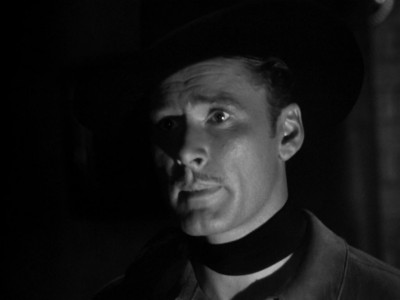
SPOILERS ALERT!
Intended by the always cash-conscious Jack Warner to be a less-expensive black & white follow-up to Flynn's successful first foray into the Western genre, 1939's Dodge City, Virginia City is an excellent example of the classical Hollywood studio system in action, taking what is essentially a "B" picture, and gussying it up with A-level talent and excellent production values. Evidently, the picture had a somewhat contentious production history (the script wasn't finalized until after shooting had started - a rarity for such a big production; Flynn's role was switched at the last moment, to his displeasure), but you'd never know from the smooth, polished, final product on display here.
That's not to say that Virginia City is the equal of its inspiration, Dodge City. It's not. But it finds Flynn at the absolute zenith of his popularity, when he was still trying more often than not to put across a serious front (before he became more..."carefree" in front of the cameras), and before serious health problems (an enlarged heart, alcoholism, drug addiction, too many women and too many sleepless nights) altered his devastatingly handsome features and impacted his top-tier movie star status. It's certainly not new to suggest that Flynn was never really asked to stretch as an actor, and to be fair, why indeed would Warner Bros. want to do such a thing? As "Errol Flynn, Swashbuckling Superstar," Flynn the action hero had worldwide fame and big box office numbers leaping off parapets and romancing Warner's stable of beauties. If the public wanted an actor, Warners could always plug in Paul Muni. Flynn certainly isn't asked to do much of anything in Virginia City except to be charming and macho in even measures, but that's okay: the film isn't much of anything, either.
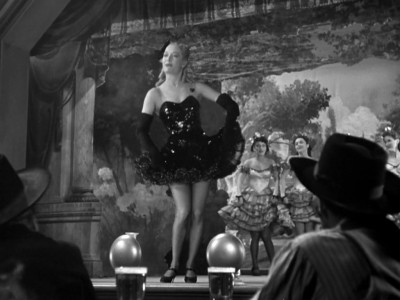
If one were to invoke the word "contrivance" when discussing the plot of Virginia City, one would be letting the film off easy. It's hokum, through and through (despite the film's opening claim that it's based on a true story), with enough plot holes to drive a wagon train through. Flynn and Randolph Scott have very few scenes together, and being antagonists throughout, there's not enough material in the first part of the film to make their "making up" at the end very believable. Even worse is the chemistry between Flynn and Hopkins. Hopkins, by now 38 years old (and looking considerably older here), looks exceedingly uncomfortable in this western get-up (watch sultry Alexis Smith in the following San Antonio to see the difference), while the 30-year-old Flynn seems less than enamored with his co-star. Of course, the actors' distress could be chalked up to being directed by Warner pro Michael Curtiz (Flynn detested him, and vice versa for Curtiz), who wasn't the most diplomatic of directors with sensitive actors (let's not even discuss the notorious miscasting of Humphrey Bogart as Mexican bandito John Murrell, the worst miscasting of such a character until Frank Sinatra's turn as Miguel the freedom fighter in Stanley Kramer's stinkeroo, The Pride and the Passion).
But despite the film's drawbacks, including the script's pallid, even-steven approach to The War Between the States, with Warner Bros. patching things up between the competing politics of the three lead characters to make sure the studio didn't lose any valuable revenue south of the Mason-Dixon line, Virginia City does have that undeniable verve and assuredness typical of a Warner Bros./Curtiz picture in their prime. There's an elemental classicalness to Curtiz's lensing that makes such carping about "miscasting" and "plot holes" and "character motivation" seem, ultimately, irrelevant. Simply put, he puts on a hellava show, and despite the 121-minute running time, Virginia City moves. Legendary stuntman Yakima Canutt gets to recreate his Stagecoach stunt of hand-over-hand traveling underneath a full team of horses and a stagecoach (which unfortunately is ruined with a couple of cutaway shots), as well as bouncing a horse down a steep, steep ravine, and there are a few well-staged gun battles that should satisfy oater fans. Virginia City looks far more expensive than most Westerns from that time period (the black & white lensing cut costs significantly), so there's a luxury of period costumes, sets, and location work that give the film a weight it wouldn't have had if the screenplay was filmed according to its own worth - as a "B."
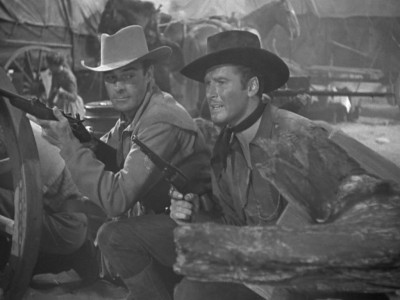
The DVD:
The Video:
The full-screen, 1.33:1 video transfer for Virginia City looks startlingly clear, with a surprisingly grain-free, silky black & white image that speaks volumes for Warner's track record with releasing their vintage library titles. Blacks are solid, and the gray scale is nicely modulated. Compression issues are non-existent. A very good presentation.
The Audio:
The Dolby Digital English audio track is big, fat mono - and that's just fine, considering that's the original theatrical presentation track. Hiss is kept to a minimum, and the sound level is more than adequate. English and French subtitles are available, along with and a close-captions option.
The Extras:
All of the movies included in the Errol Flynn - The Warner Bros. Western Collection feature the old Warner Night at the Movies marketing strategy of including short subject, cartoon, and newsreel bonuses to replicate what it would be like to see, in this case, Virginia City, at a typical local movie house (minus the "B" programmer at the bottom of the bill). I've always enjoyed this feature from Warner Bros. (I believe they did this with their first VHS releases back in the '80s, when nobody was putting "extras" on a video), and I don't know why they don't promote it more strongly on the front covers of these DVDs.
First off, we have a feature length commentary track (okay...they didn't have those at 1940s movie houses) by film historian Frank Thompson. He focuses mostly on the production history of the film (reading memo excerpts, discussing shooting days, location work), eschewing any deep analysis of the film - which is fine by me. Hitting the "Play All" option for the Warner Night at the Movies bonus, we're treated to first, a vintage newsreel featuring footage from the Admiral Byrd expedition. Next, we have two 1940 Technicolor shorts: Cinderella's Feller (a live-action kids' version of the fairy tale directed by William McGann and starring "Baby Jane" Juanita Quigley and Scotty Beckett) and The Flag of Humanity (the story of Clara Barton, as directed by Jean Negulesco and starring Nana Bryant), each running about twenty minutes. Next, two cartoon shorts are offered: Cross Country Detours (a Tex Avery directed effort about national parks, featuring the voice work of Mel Blanc and Bea Benaderet), and Confederate Honey (a non-P.C. Friz Freleng parody of Gone With the Wind starring a very early Elmer Fudd, that's been made thoroughly P.C. by having copious amounts of obvious and crude editing performed - a shame). There are trailers included for Virginia City and A Dispatch From Reuters, but an extended trailer/behind-the-scenes featurette, The Light Brigade Rides Again, for Flynn's The Charge of the Light Brigade, is separated from the Warner Night at the Movies (perhaps because it's not from 1940).
SAN ANTONIO
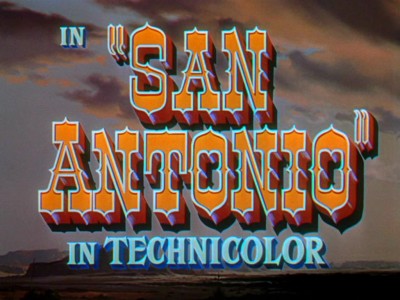
It's 1877 on the Chisum Trail. The range war between cattle ranchers and cattle rustlers has become quite bloody, resulting in many of the ranchers being driven off their land and down to Mexico, fearing for their lives. Cattle rancher Clay Hardin (Errol Flynn), recovering from serious wounds at the hands of rustler Roy Stuart (Paul Kelly), has finally uncovered the proof he needs - a tally book with all of Stuart's transactions - that Stuart illegally sold cattle he stole from Hardin's and other ranchers' herds. Met by his friend Charlie Bell (John Litel), Hardin returns to San Antonio, looking for vengeance.
On the way there, Clay encounters high-toned singing star, Jeanne Starr (Alexis Smith), who, along with her manager Sacha Bozic (S.Z. Sakall) and dresser Henrietta (Florence Bates), is traveling to San Antone for a singing engagement. Clay flirts with her on the in-bound stage, and clues her in to the rough and tumble saloon she'll be appearing in -something that doesn't sit well with the haughty, gorgeous Starr. Before reaching San Antone, at a stop-off, Clay encounters Lafe McWilliams (Tom Tyler), a gunslinger hired by Stuart to kill Clay. Clay dispatches him easily, and decides to slip into San Antonio quietly - but not before he falls for Starr (who seems to return the feeling).
Jeanne arrives in town, and proceeds to enchant the largely male-only San Antonio. Legare (Victor Francen), the owner of the saloon where Starr will appear, is obviously attracted to her, as is Roy Stuart, who's involved in illegal activity with Legare, as well. Once Clay makes his appearance, the whole town waits for Clay and Roy to shoot it out, but not before hearing the incandescent Starr perform her first number. Immediately after, when he sees Clay and Starr embrace, Roy decides to take out Clay, but fails. Legare, however, doesn't fail in killing Charlie Bell, which sets into motion a series of double-crosses and killings for Clay and Roy.
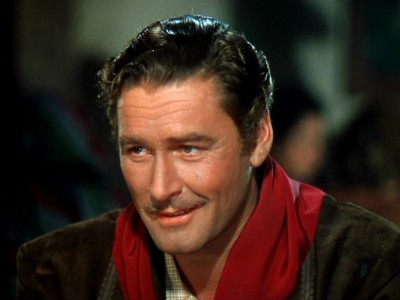
SPOILERS ALERT!
Far more relaxed and fun than the higher-budgeted Virginia City, San Antonio's luridly-hued Technicolor visual scheme is perfectly suited to the comic-book style adventure on display here. With a breezy script by heavyweight pros W. R. Burnett (High Sierra, This Gun for Hire, The Great Escape) and Alan Le May (novels The Searchers and The Unforgiven), who must have been in a lighthearted frame of mind, and nimble-footed direction by genial studio journeyman David Butler (Road to Morocco, By the Light of the Silvery Moon, The Command), San Antonio almost has the feel of those later self-reflexive westerns such as Aldrich's Vera Cruz or even some of the lesser spaghetti westerns out of Italy (minus the outsized violence, of course). Even though the story itself isn't comical by design, the approach is far from the serious demeanor of Flynn's earlier Virginia City. This is a lark, even with the stentorious Max Steiner score (one of my favorites of his), and the central theme of murderous, delayed revenge.
Certainly Flynn's loose-as-a-goose performance helps set the overall tone of the film. While still a big, big star, by 1945 he was already ten years into being an "overnight" sensation, and the heat was off his career. His notorious statutory rape trial of 1942 is often described as not only not hurting his career but actually helping it, but anyone looking at the subsequent caliber of his films from that date onward, as well as his performances in them, will suspect that may not indeed be the case. By 1945, Flynn wanted to leave behind the swashbuckling, Western action-hero roles that he had been typecast into, but it wasn't meant to be, and although it's obvious San Antonio was a class-act from Warner Bros., it's pretty clear that with Flynn being stuck in another Western, Warners meant to let Flynn ride out his use to them in increasingly unimportant vehicles.
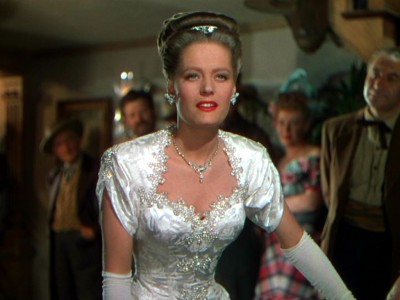
Pro that he was, though, Flynn doesn't let his disappointment show (at least not yet in San Antonio). He's apparently game for anything here, showing an easy grace with the action, romance and comedy that, as far as I'm concerned, hasn't been matched by anybody before or since on the big screen (Flynn could have been the penultimate James Bond, twenty years later). After all, was there ever a more handsomer sonafabitch than Errol Flynn? And with a physicality that was even more fluid and natural than his later swashbuckler successor, Burt Lancaster, Flynn projected a powerful sexual allure that women still find credible, and men continue to want to emulate (critically, Flynn's "man's man" appeal was more in line with Gable's, rather than the chilly, remote Cary Grant's, which attracted far more female than male admirers). In San Antonio, Flynn is clowning constantly (singing to John Litel, flirting with gorgeous Alexis Smith - watch his hilarious window entry into the stagecoach, where he's frankly astounded by the less-than-fetching countenance of Florence Bates, before he sights Smith, and flashes that million dollar smile of his), but not in a heavy, obvious way. He's light, in the best sense of that word. That, combined with the requisite macho action gunplay which he effortlessly pulls off, and Flynn projects an irresistible "maleness" that has yet to be duplicated today (when one considers that today's most successful "swashbuckler" is androgynous-on-his-best-day Johnny Depp, it's a cause for real pause among moviegoers).
And luckily for "man's man" Flynn, he has a real woman to play off here: the entirely delectable Alexis Smith. There's a steadiness to Smith's lynx-eyed gaze that perfectly compliments the roguish, killer charm entreaties of Flynn; they're a perfect match. She's not above clowning herself here in San Antonio (I love it when she makes a snotty face like a little kid at tough-guy Tom Tyler...and then laughs at him), but she's perfectly suited in presenting a fantasy image of a female heroine who's both desirable and attainable - if you've got the sand to make her your own (her rendition of Some Sunday Morning is exquisite) Cagey Paul Kelly (one of my favorite enigmatic anti-hero villain players) strikes the right note against Flynn's drollery (Kelly may have the funniest line in the film when, after watching a kitty lap up his whiskey, he deadpans, "Get that drunken cat off the bar.") - which is a nice respite from S.Z. "Cuddles" Sakall's shameless hamming (I've never been a fan of his shtick). Events get a little thick towards the end, and Butler blows the climatic brawl between Flynn and Kelly (over too soon, and awkwardly staged, to boot), but enough snappy scenes earlier in the film (Flynn's killing of Tyler in particular, is remarkable, with the gunslinger turning around and walking away, even though he's already dead) make allowances for this downturn. One of Flynn's most enjoyable Westerns.
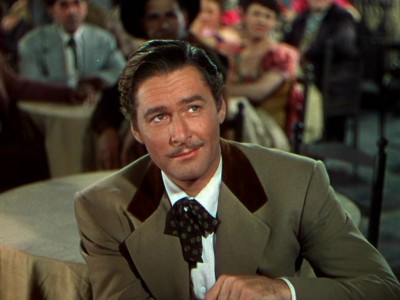
The DVD:
The Video:
Although most of the full-frame, 1.33:1 video transfer for San Antonio looks quite good, approximating its original Technicolor glory correctly, I spotted numerous scenes (not just a few) where the registration was decidedly off. It wasn't a deal-breaker, but it was noticeable. Otherwise, the print used was fairly clean (minor scratches and dirt, here and there), with no compression issues.
The Audio:
There was a surprising amount of hiss and crackle on the Dolby Digital English soundtrack (in comparison to the first film in the set), but once you become used to it, you don't notice. All dialogue was cleanly heard, with English and French subtitles available, along with close-captions.
The Extras:
All of the movies included in the Errol Flynn - The Warner Bros. Western Collection feature the old Warner Night at the Movies marketing strategy of including short subject, cartoon, and newsreel bonuses to replicate what it would be like to see, in this case, San Antonio, at a typical local movie house (minus the "B" programmer at the bottom of the bill). First, there's a newsreel memorializing General George S. Patton, who had died from injuries sustained in an automobile accident. It runs 1.51. Next, three short subjects are up: Frontier Days, featuring a gorgeous young brunette Dorothy Malone (there's a hell of a barroom brawl, too); Peeks at Hollywood, featuring Flynn, along with Arthur Lake and Jane Withers; and the Oscar-nominated Story of a Dog, a fascinating look at the Coast Guard training war dogs for duty in the Pacific. Two cartoons are included: A Tale of Two Mice (which as been dubbed over), and Wagon Heels, with Porky Pig. Trailers are included for San Antonio and The Corn is Green.
MONTANA
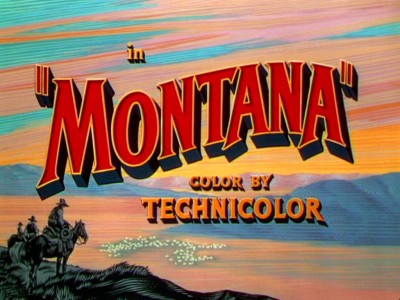
Flynn plays Morgan Lane, an Australian who's returning to the Montana Territory to avenge his father who was run off his land during the sheep/cattle range wars some years back (Lane's father was a sheepman). Out on the plains, the big cattle ranchers shot on sight anyone connected with sheep, believing the superstition that sheep foul the land for grazing cattle. Lane and his Scottish sidekick MacKenzie (Charles Irwin) aim to educate those ranchers differently - chief among them, Maria Singleton (Alexis Smith), who controls a big track of land inbetween ranchers Rodney Ackroyd (Douglas Kennedy), who's Maria's fiancé, and George Forsythe (Lester Matthews). When Morgan "tricks" Maria into leasing a track of valuable land for his sheep, she declares war on him, even though Morgan gets Forsythe and smaller cattle men (jealous of Maria's power) to side with the sheep.
SPOILERS ALERT!
Montana is a fairly anonymous little Western which can't seem to get up and go until its patently ridiculous ending. While it's surprising that such talent as James R. Webb (Vera Cruz, The Big Country, Cape Fear) and Borden Chase (Red River, Winchester '73, Bend of the River) would deliver this stillborn screenplay, at just 76 minutes running time, it's not a stretch to presume that some important elements from Montana may have been eliminated from the final shooting script or edit. And that running time ensures that despite the film's obvious drawbacks, it's over quick enough, providing the barest minimum requirements for an oater time-passer.
Aside from Flynn's obvious disinterest in the project, Montana's biggest problem is its stunted production. While the story of the sheep/cattle wars has never really been a popular or compelling backdrop for American westerns (visually, it's such a jar for the viewer, seeing the big, muscular, jostling, dangerous cattle being roped and branded and herded by tough cowboys...versus the fuzzy little sheep, placidly herding themselves along behind a lone herder and a collie or two), the problem here isn't so much that we're not engaged properly with Flynn's desire for sheepherding to take its rightful place among cattle ranching (that why they added the angle of his father being run off, to set the revenge motif). It's that the fleshing out is so thin that we never really believe any of it. We don't buy Flynn as a sheepman. We don't buy Smith as a tough rancher. We don't buy S & A Ranch foreman Slim Reeves (Ian MacDonald) as a particularly formidable villain. It's all too pat, too rushed, for any of it to sink in properly.
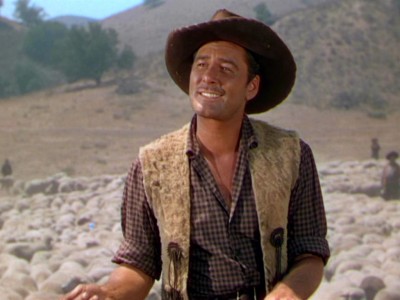
The movie starts out hard, with words about men taking the land by force and aiming to keep it, but then the film grinds on with endless scenes of Flynn wooing Smith, and being misunderstood by Smith, and Flynn being pushed around by Reeves, until the cattle stampede finale that's as unintentionally funny as it is almost completely nonsensical. The budgetary limitations of Montana are most evident in these final scenes, where everybody gets up on chairs in front of faded, fuzzy rear projection shots, and pretends they're on horses. That may have been a common practice back then, but I've seen much better examples of such mock-ups from that period - they're woefully inadequate here (my favorite is one shot of Flynn supposedly tear-assing down on some rustler, but neither the background nor Flynn actually move: he appears to be hovering benevolently along as if by rocket backpack). Slim's death is even more amusing, with an obvious dummy getting trampled that looks like a gag out of a Three Stooges short. Even worse, none of the geography of the stampede seems to make sense, with the viewer totally at a lost as to who's riding where, what they're going to do when they get there, and how they got out of the way of those cattle - who never appear in the same shot as the principles. Since Montana has so few action scenes, the payoff should have been this stampede. Unfortunately, it plays more like a scatterbrained trip to the outhouse.
Flynn's physical appearance mirrors the film's confused framework, as well. In most of the exterior shots, he looks quite good, actually: trim, healthy, ruddy, with a quick smile and an assured gait. He may not be the Flynn of Virginia City ten years prior, nor even the Flynn of San Antonio just five years before Montana, but he still beats most of us on our best days. It's only once we go indoors for the film's interior shots (which make up a distressing majority of the scenes in the film) that we see the ravages that booze, drugs, sleepless nights, endless cigarettes, and too many women (lucky bastard) have visited upon Flynn. Perhaps Flynn was on better behavior out on location, getting a little bit of sun and exercise on his horse - only to really start up a bender once he was back on the Warner lot for all the interior shots. Who knows. But it's a startling transformation when you first see it. He has Smith to act against here, but she seems distracted and a little put-out (not surprising considering the very little she's asked to do here). About the only memorable scene - for all the wrong reasons - they have together is when they sing a little Western ditty together (entirely unmotivated, of course). Flynn actually gets to scat a little, but it comes off as forced and silly - just like the film as a whole. And S.Z. "Cuddles" Sakall (jesus) is back, doing what he always does: annoying the hell out of people (despite audiences who loved him, other actors hated playing against the scene-stealing ham). And frankly Flynn, although he never acts as if he's slumming, is slumming here in a harmless but woefully inept "B," and he obviously knows it. The sparkle in his eye, is gone.
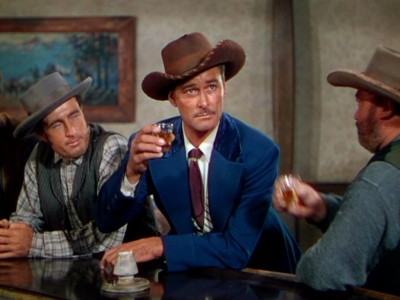
The DVD:
The Video:
The full-frame, 1.33:1 video transfer for Montana blows hot and cold, with registration problems throughout the Technicolor print, as well as scratches, dirt, and at times, a jiggering problem with the image that I'm chalking up to a compression issue (it almost looked like the old time-compression trick they'd pull with videos). Overall, the image is acceptable, with adequate color range (except for the faded process shots), and a reasonable sharp picture.
The Audio:
There's more hiss and crackles in Montana, but not as much as there was in San Antonio. Overall, the Dolby Digital English mono track is entirely adequate for the job here. English and French subtitles, and close-captions, are included.
The Extras:
All of the movies included in the Errol Flynn - The Warner Bros. Western Collection feature the old Warner Night at the Movies marketing strategy of including short subject, cartoon, and newsreel bonuses to replicate what it would be like to see, in this case, Montana, at a typical local movie house (minus the "B" programmer at the bottom of the bill). First up, if you hit the "Play All" option, is a vintage newsreel bit, very short, showing an invasion of frogs plaguing Paris (make your own joke). Next, there's a Joe McDoakes short, So You Want a Raise, starring George O'Hanlon (these are always funny). It runs almost eleven minutes. It's Hummer Time is a Robert McKimson cartoon short from 1950 (with that anonymous cat you think at first is an earlier Sylvester). There's also trailers for Montana and Humphrey Bogart's 1950 Warner effort, Chain Lightning. Separated from the Warner Night at the Movies option (because they were produced before 1950) are the first three Western programmers from the Warner Bros. Santa Fe Trail 2-reeler series, starring Robert Shayne (as different protagonists). Oklahoma Outlaws and Wagon Wheels West were produced in 1943, and Gun to Gun in 1944. Plenty of brawlin'. Plenty of pistol action.
ROCKY MOUNTAIN
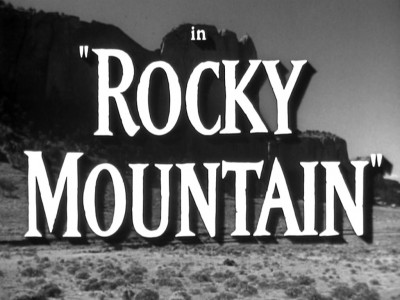
Captain Lafe Barstow (Errol Flynn), of the Confederate Army, has been sent on a suicide mission 2,000 miles away from the front lines of the Civil War to California, where he's to meet up with Cole Smith (Howard Petrie), a renegade outlaw and Confederate sympathizer who promises to round up a second army to aid the South. Lafe and five other men make their way across the unforgiving desert to a huge outcrop of mountains, where they witness an attack on a fleeing stagecoach by Shoshone Indians. While Smith, masquerading as "California Beal" to check out Lafe and his men before revealing his identity, cautions against Lafe interfering, the Confederate soldiers come to the stagecoach's rescue, where after the battle, only the driver, Gil Craigie (Chubby Johnson) and passenger Johanna Carter (Patrice Wymore) survive.
Faced with the prospect of ferrying around two civilians, events become more complicated when he discovers that Johanna's fiancé is Lieutenant Rickey (Scott Forbes) of the Union Army, who is sure to mount a search for his fiancé who was on her way to visit him at Fort Churchill. Lafe uses Johanna as bait for Rickey when he comes, forcing her (by threat of killing her fiancé) to welcome Rickey into Lafe's camp, where he's ambushed by Lafe's men. Lafe ponders what to do next when he realizes that not only will Rickey not succumb to being a passive captured prisoner, but that the Indians will soon be back to attack the outnumbered soldiers.
SPOILERS ALERT!
Written by Winston Miller (My Darling Clementine, The Far Horizons, Lucy Gallant) and Alan Le May (based on his story, Ghost Mountain), and directed by Flynn's The Adventures of Robin Hood co-director, William Keighley, Rocky Mountain is a beautifully tense, somber little chamber Western (it reminded me in some ways of Aldrich's similarly neglected Ulzana's Raid), strikingly directed by Keighley, featuring a nicely world-weary performance by Flynn. It's not a title I was familiar with (except for knowing it was the film where Flynn met his fourth wife, Wymore), but I was impressed with its gritty, morose attitude and its surprisingly downbeat ending.
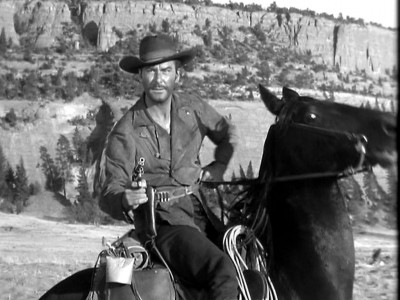
By the end of 1950, Flynn's career looked like it was going to be dominated by minor vehicles like his previous release that year, Montana. The last time Warners splurged any serious money on him was for 1948's The Adventures of Don Juan (a lot of that due to budget overruns caused by Flynn's rapidly increasing addictions) - and that flopped at the box office. Reports vary as to whether or not he really wanted to do Rocky Mountain, his last Western. One might read his grim tone in the film as distaste at having to saddle up again (he didn't particularly like performing in this genre), or, hopefully, his pleasure at getting a role outside his normal genial, charming, roguish range. The Flynn seen here is quite different from the laughing, sexy, courtly gentleman tough guy we see in the previous three films. In Rocky Mountain, Flynn is believably weather-beaten, and beaten down emotionally, mourning the loss of a woman who used to love him, and mourning the death and destruction he's seen during the war. In his scenes with Patrice Wymore, he's not at all flirty (a seeming impossibility, considering his branded image), instead essaying a cautious, distant, doomed romanticism that makes itself known when he belies his own killer instincts (he shoots one of the Union soldiers in cold blood), deciding to sacrifice himself and his men to save Wymore. His performance is a hint of where Flynn could have gone, if he had half-cared to exert himself (I suspect at this time, acting was becoming more of just a means of making money, rather than an aspired-to craft). Later self-deprecating (some said self-parodying) turns in films like The Sun Also Rises and The Roots of Heaven were broad, sentimental turns - excellently done, but not a stretch for the already talented Flynn. No, his performance here points to places he might have gone if he could have hooked up with a director who cared to shepherd him through a change in his screen persona (perhaps like Randolph Scott with Budd Boetticher, or Anthony Mann with Jimmy Stewart, for their career transition Westerns).
The film itself is an intriguingly dark tale, both thematically and physically (I love the almost noir-ish cinematography - no mean feat out in the sun-baked deserts of New Mexico, standing in for California). Unfolding as primarily a character study masquerading as an action piece, Rocky Mountain takes plenty of time for us to get to know the motley group of men who make up Lafe's improbable team, giving each of them a chance to connect with the audience in either backstories told or actions that are sympathetic to their current plight. Once we get to know them, the tension rises as we realize that their fatalistic talk is probably correct: they're not going to get off that rock outcrop (Keighley brilliantly keeps the action tightly restricted to this one claustrophobic location). Either the Indians or the Union soldiers are going to kill them. And once we accept that, we hope against the inevitable that somehow, they'll be rescued by the Union soldiers, led by a respectful Rickey, when Lafe and his men make their final stand against the Indians so Johanna can escape - a belief made plausible by the fact that this is 1950, and big heroes like Errol Flynn don't die at the hands of the Indians in what looks to be a standard "B" programmer. But that's exactly what does happen. Facing down overwhelming odds, the band gets picked off, one by one, until Lafe, with two arrows in his back, falls into the sand, stone dead. It's a surprising end (especially if you're aware of how few times this happened in a standard Hollywood film from that era), and an entirely believable one. Rocky Mountain is one of Errol Flynn's best unsung films.
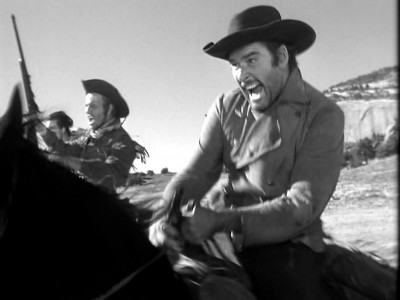
The DVD:
The Video:
The full-screen, 1.33:1 black & white video transfer for Rocky Mountain is crystalline clear, with inky blacks and shimmering whites. Very little screen anomalies, and no compression issues to speak of. Beautiful, sharp picture.
The Audio:
The Dolby Digital English mono track has a very slight hiss, but nothing outside the range of acceptable for this type of film. English and French subtitles are included, as well as close-caption options.
The Extras:
All of the movies included in the Errol Flynn - The Warner Bros. Western Collection feature the old Warner Night at the Movies marketing strategy of including short subject, cartoon, and newsreel bonuses to replicate what it would be like to see, in this case, Rocky Mountain, at a typical local movie house (minus the "B" programmer at the bottom of the bill). First, there's a full length commentary track by Flynn biographer, Thomas McNulty. For the Warner Night at the Movies feature, a newsreel, missing its audio track (so...why put it in here?) details flooding in the west. There's a Joe McDoakes comedy one reeler, So You Want to Move, along with a cartoon, Two's a Crowd (featuring Claude Cat, always a favorite), and trailers for Rocky Mountain and The Breaking Point. Separate from the Warner Night at the Movies are three 2-reeler programmers: Roaring Guns and Trial by Trigger (both starring Robert Shayne as part of Warners' Santa Fe Trail series), and Wells Fargo Days, with Dennis Moore.
Final Thoughts about the Boxed Set:
Errol Flynn and Western fans will do well to purchase the Errol Flynn - The Warner Bros. Western Collection set, which features four interesting titles in Flynn's Western oeuvre - particularly the excellent, underrated Rocky Mountain. The transfers for the most part are quite good, while Warners does their usual excellent job of including some fun extras for each film. I highly recommend Errol Flynn - The Warner Bros. Western Collection.
|
| Popular Reviews |
| Sponsored Links |
|
|
| Sponsored Links |
|
|
| Release List | Reviews | Shop | Newsletter | Forum | DVD Giveaways | Blu-Ray | Advertise |
|
Copyright 2024 DVDTalk.com All Rights Reserved. Legal Info, Privacy Policy, Terms of Use,
Manage Preferences,
Your Privacy Choices | |||||||









